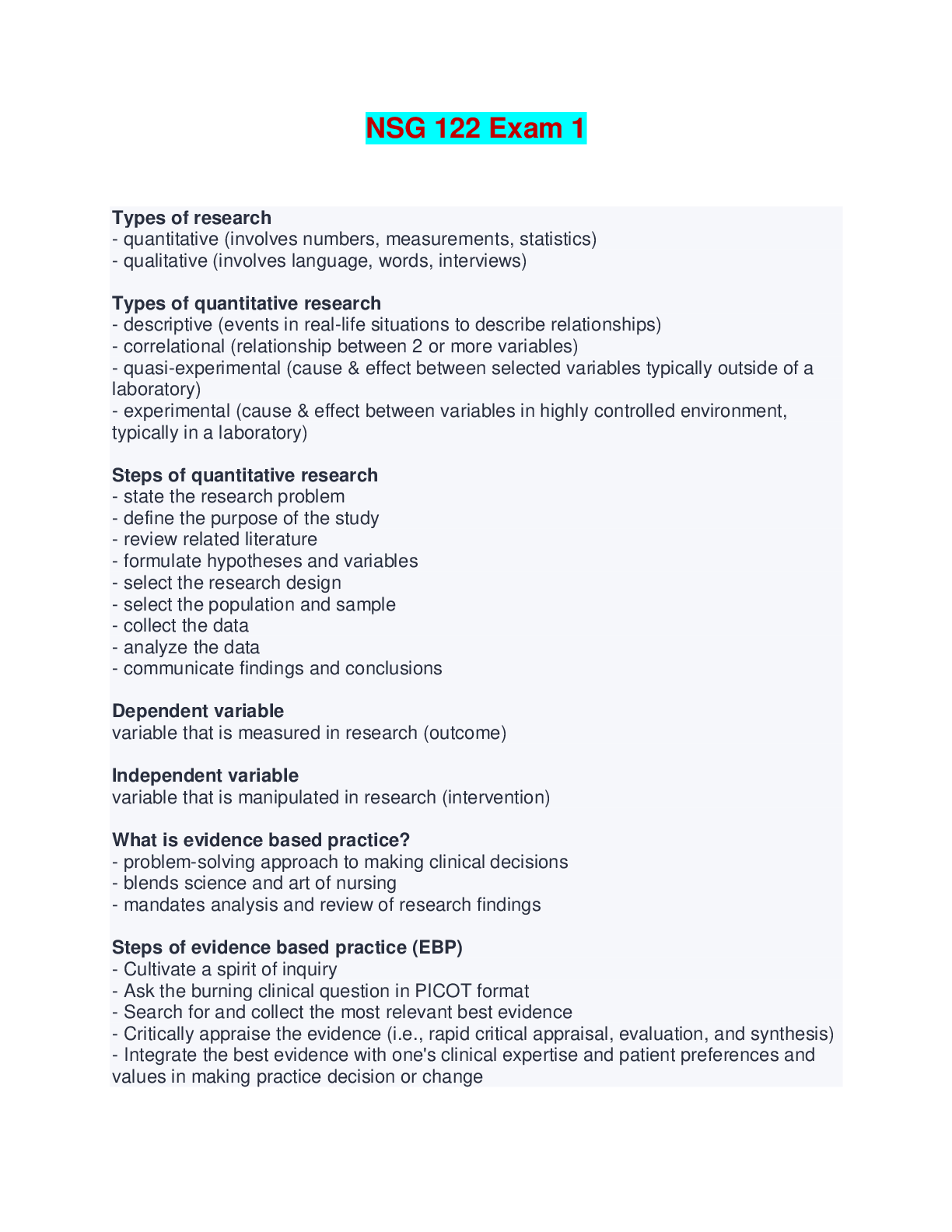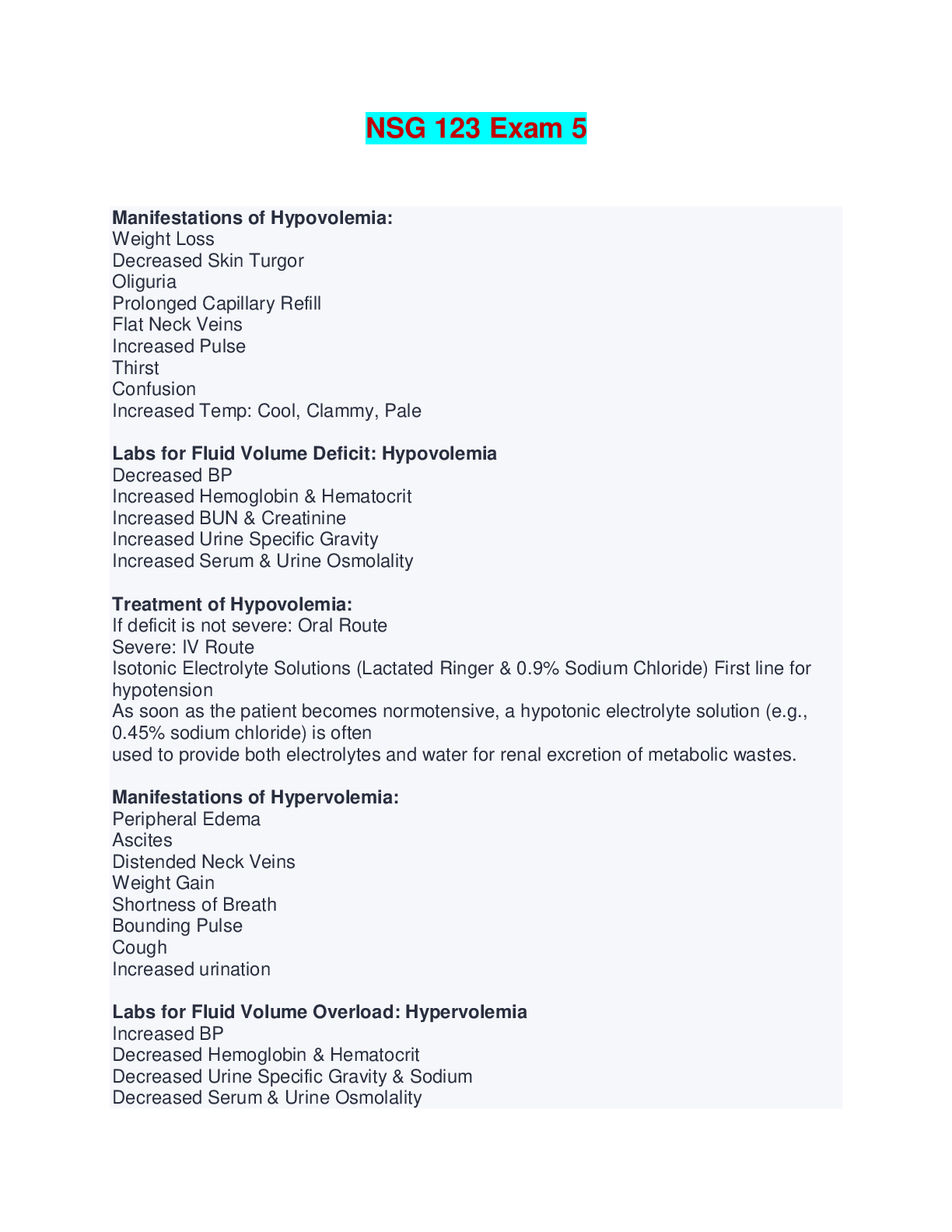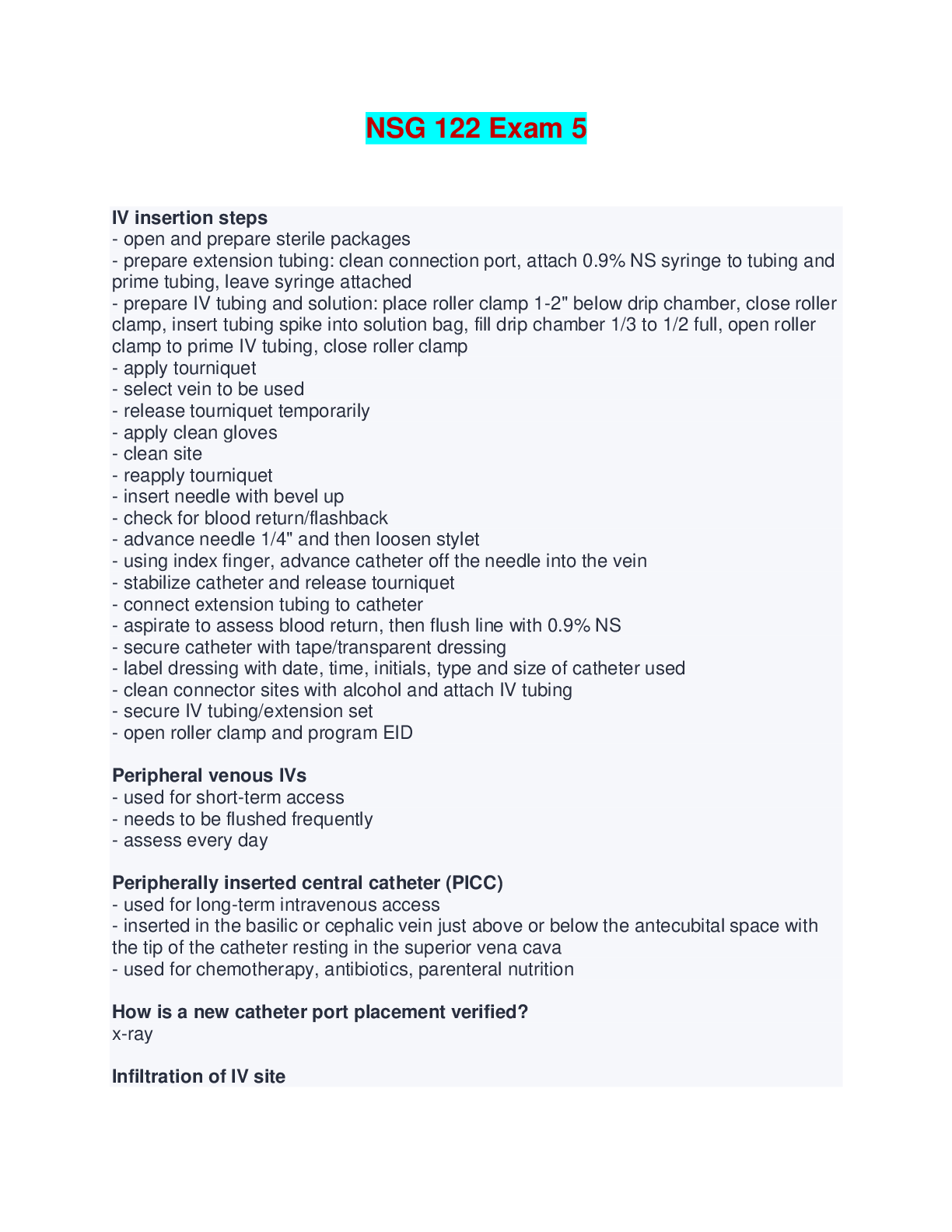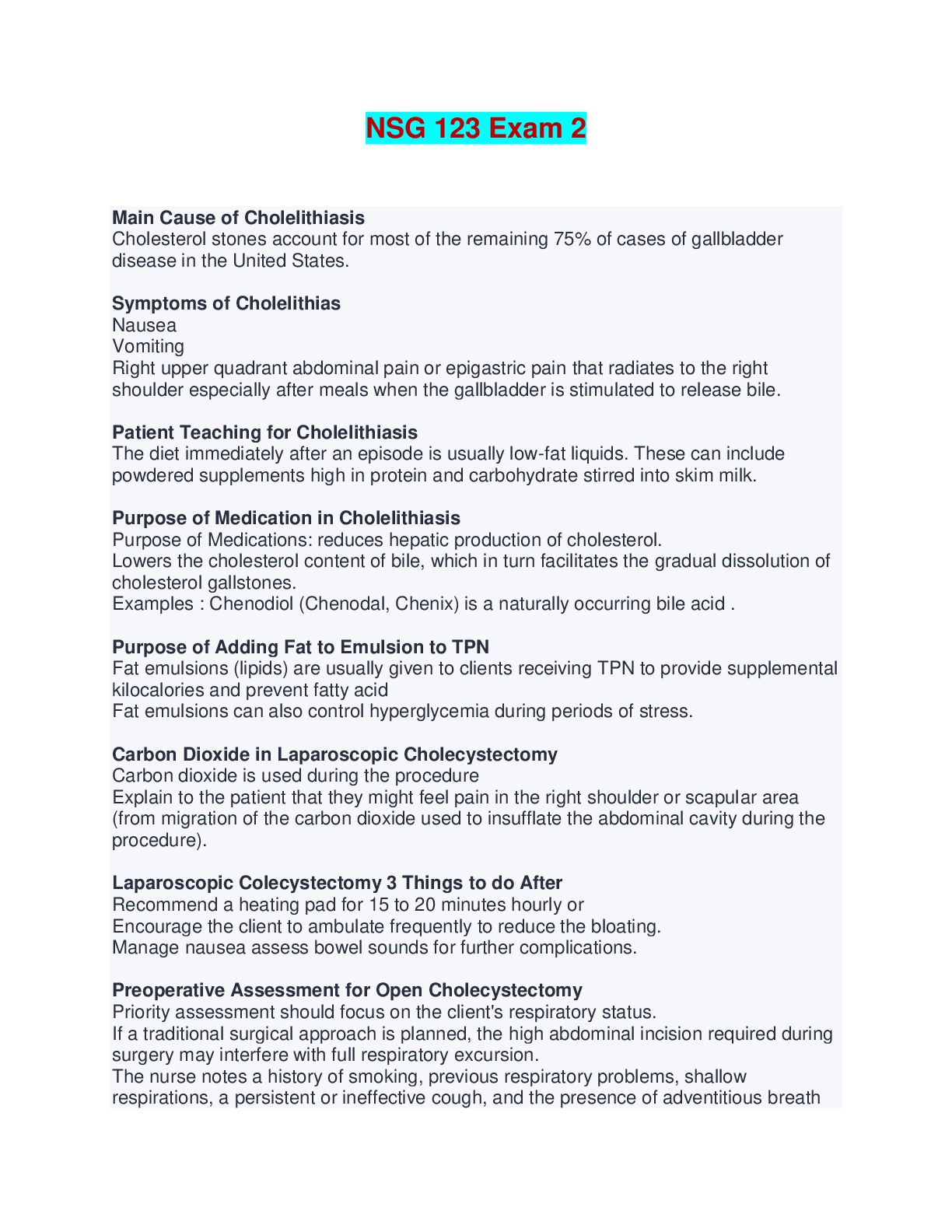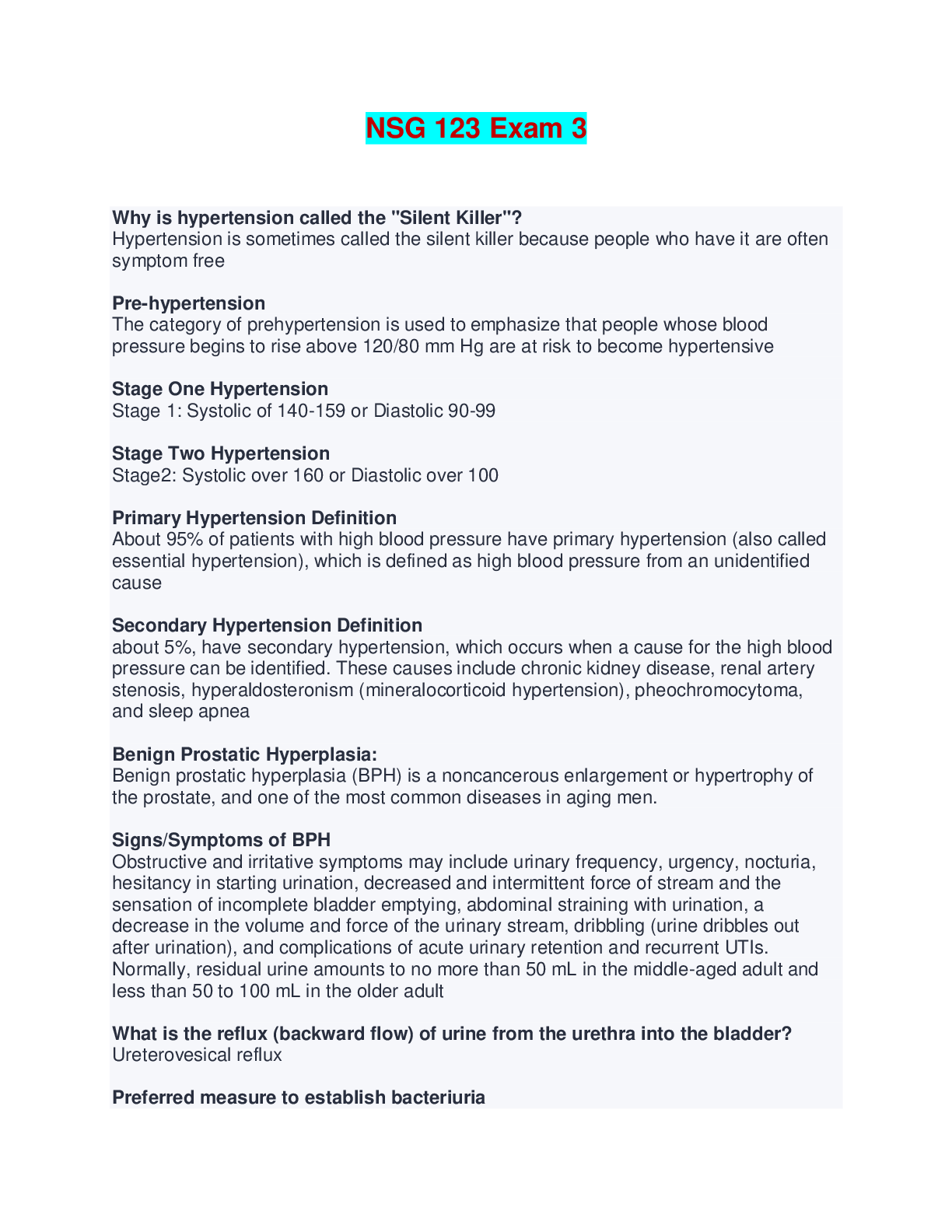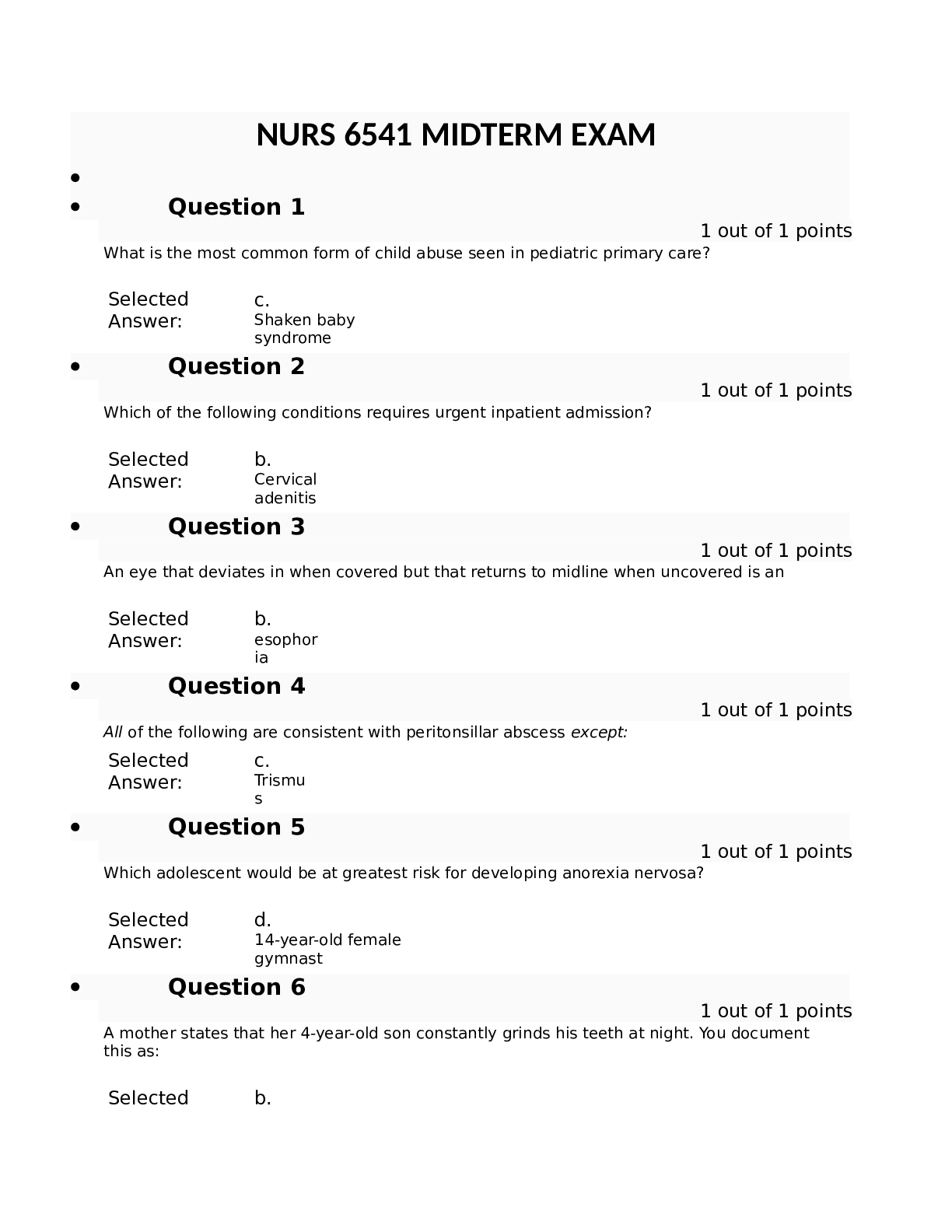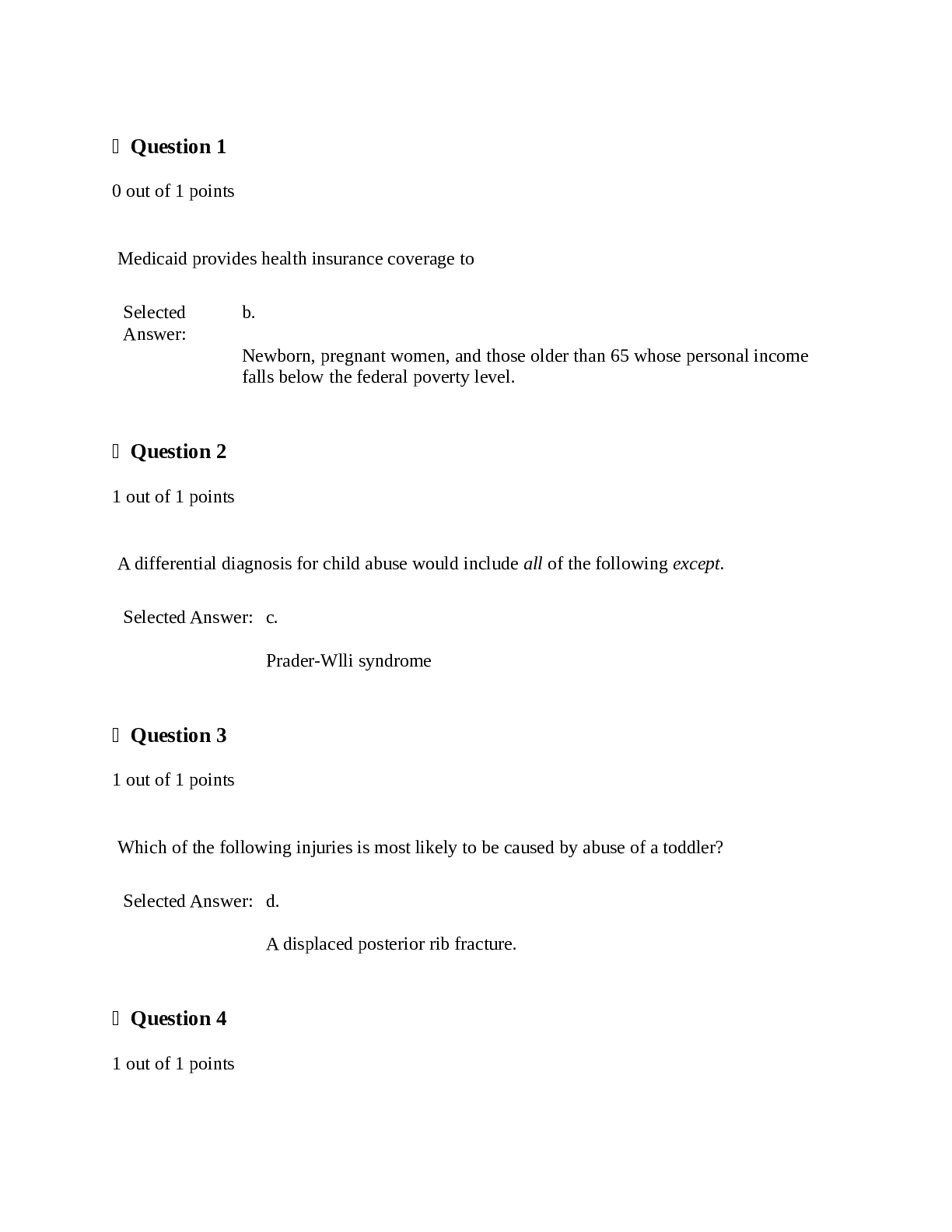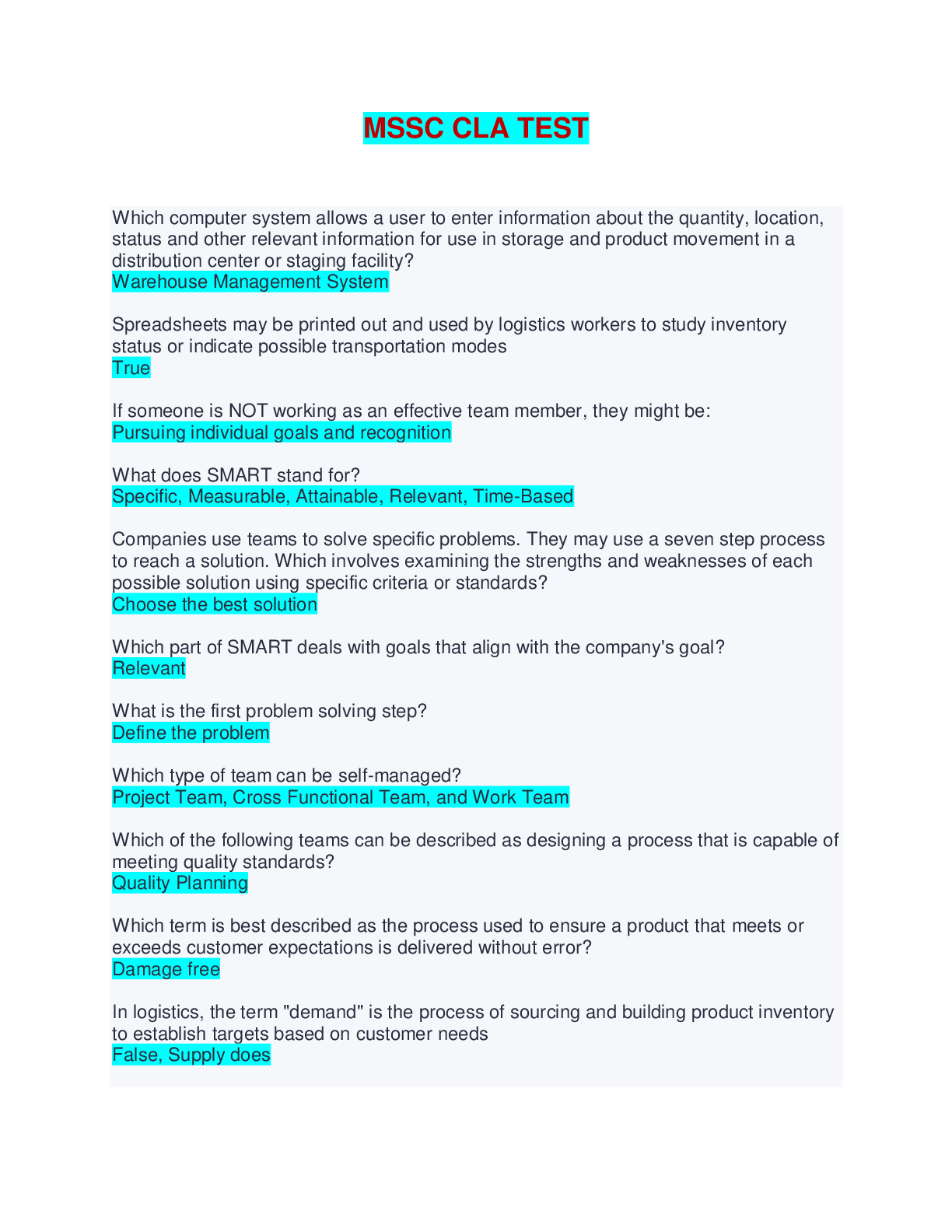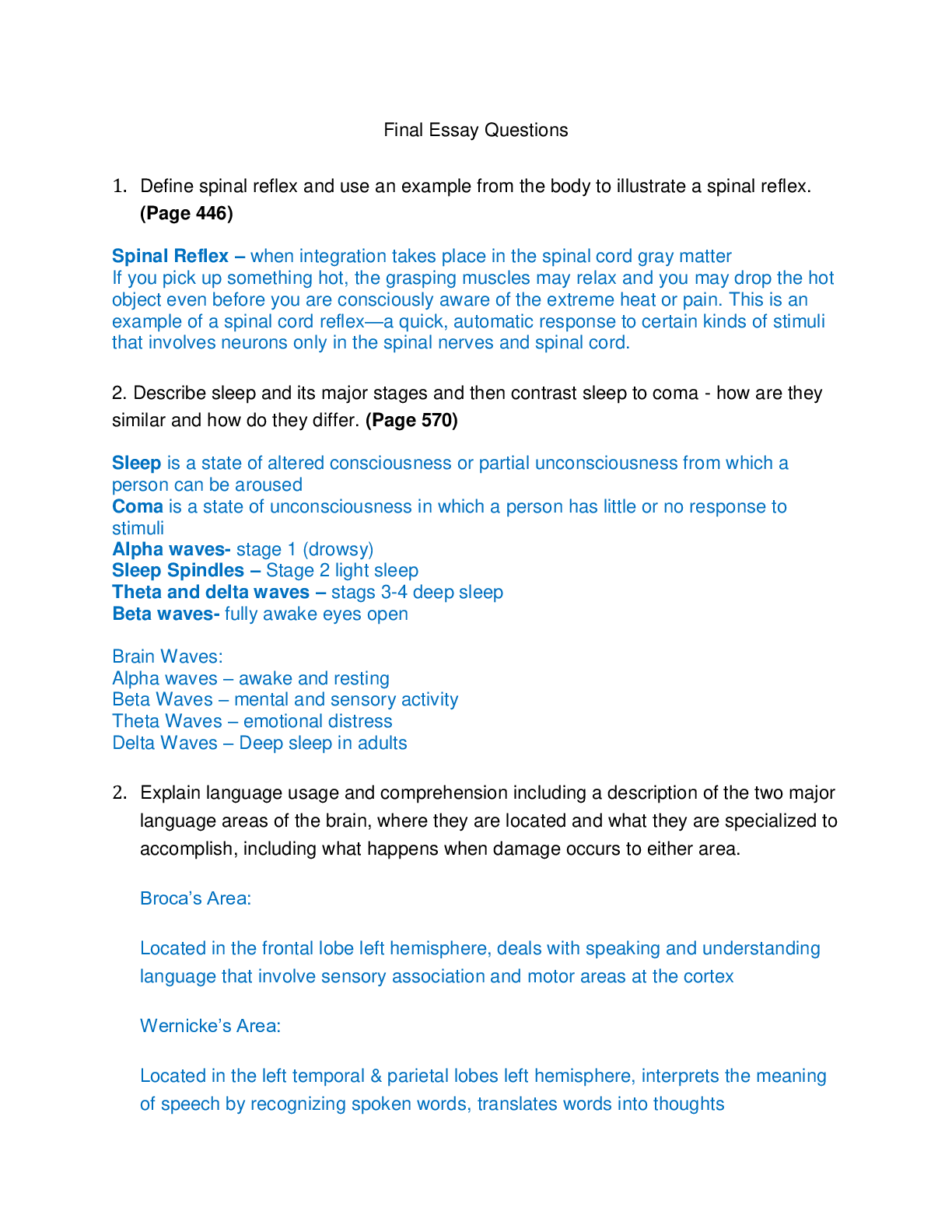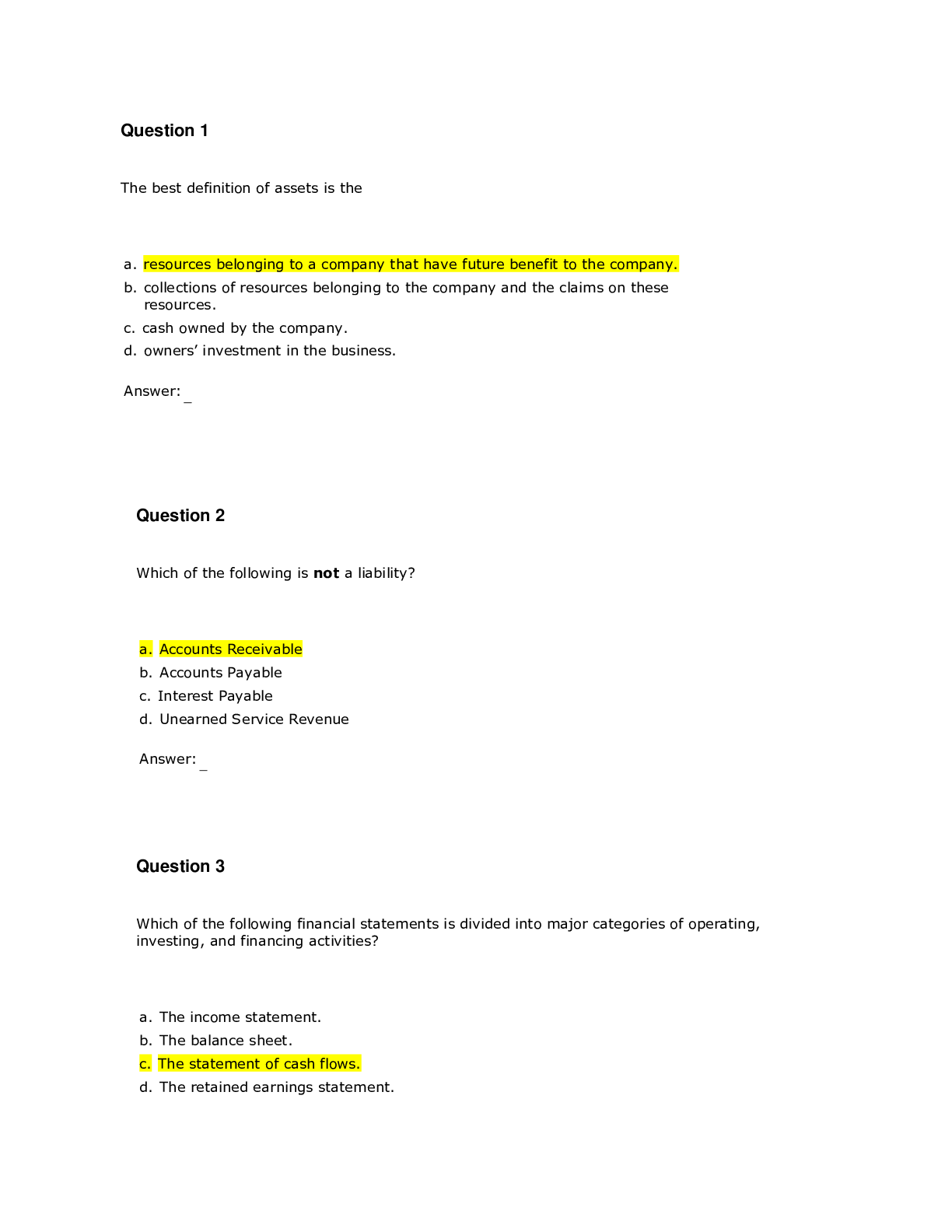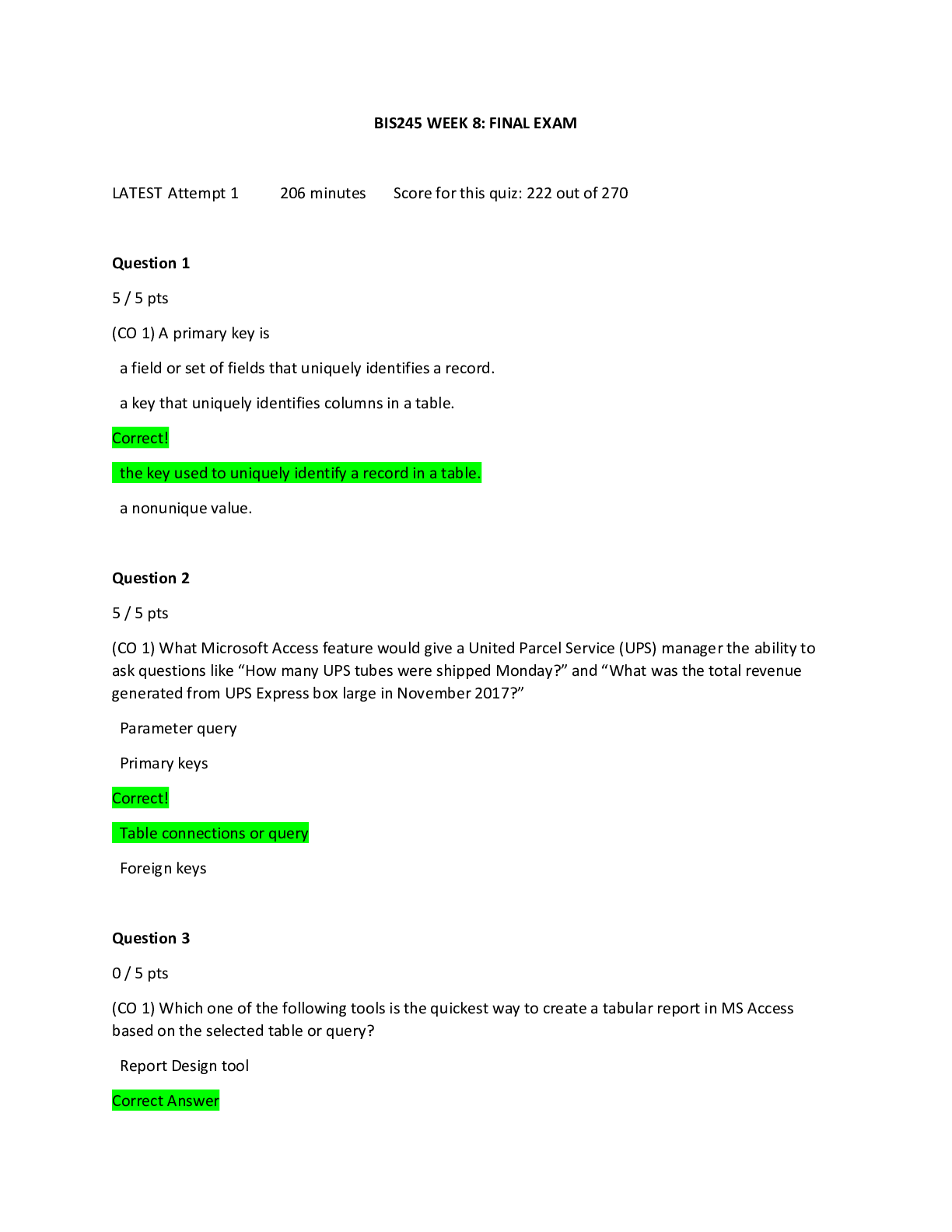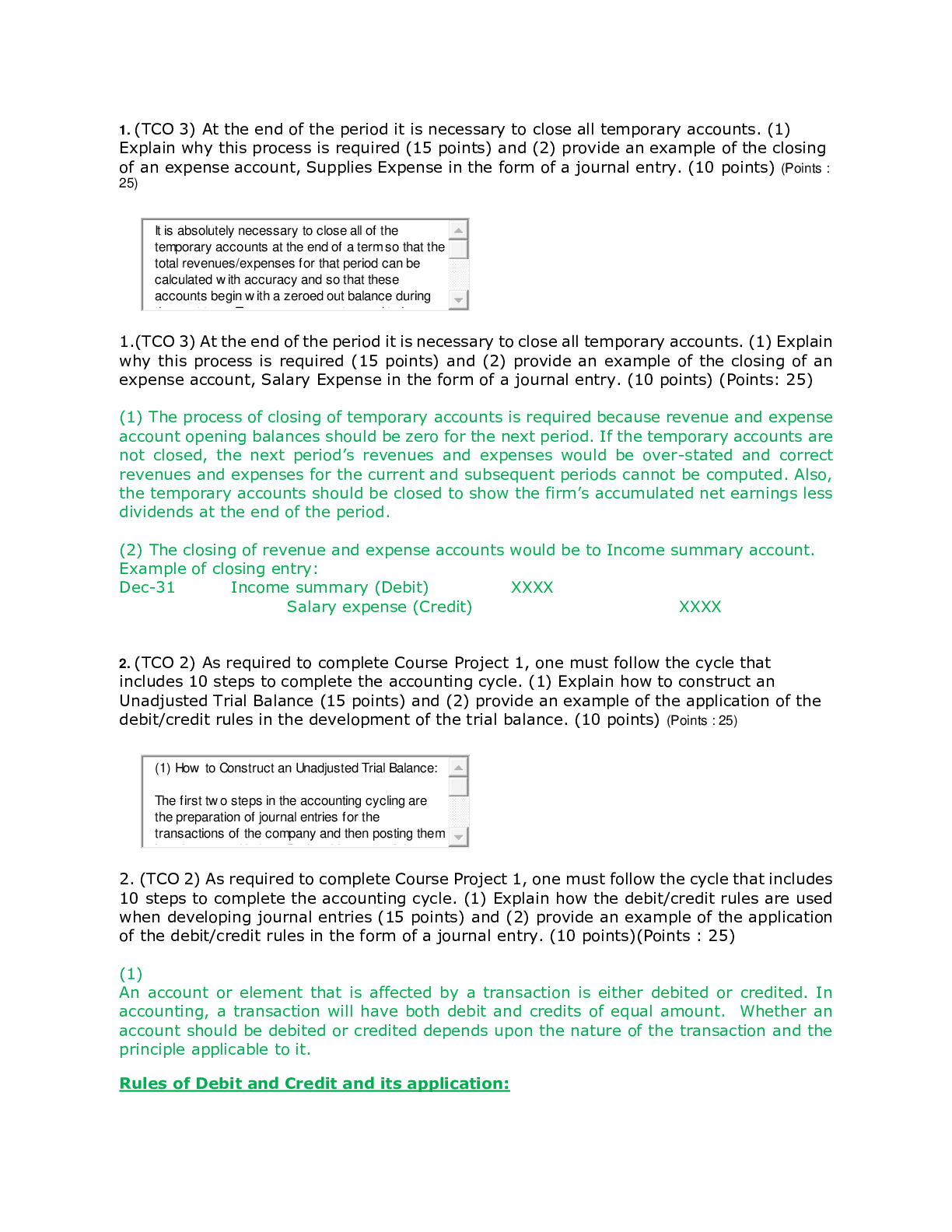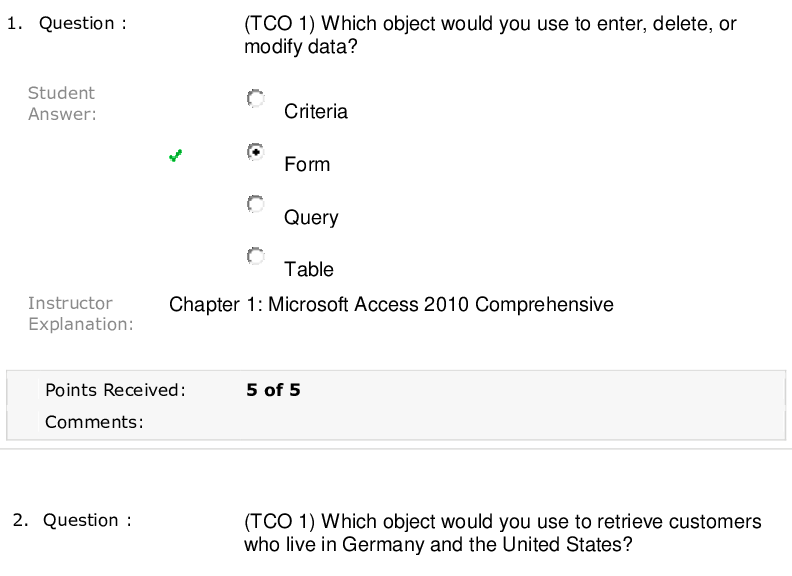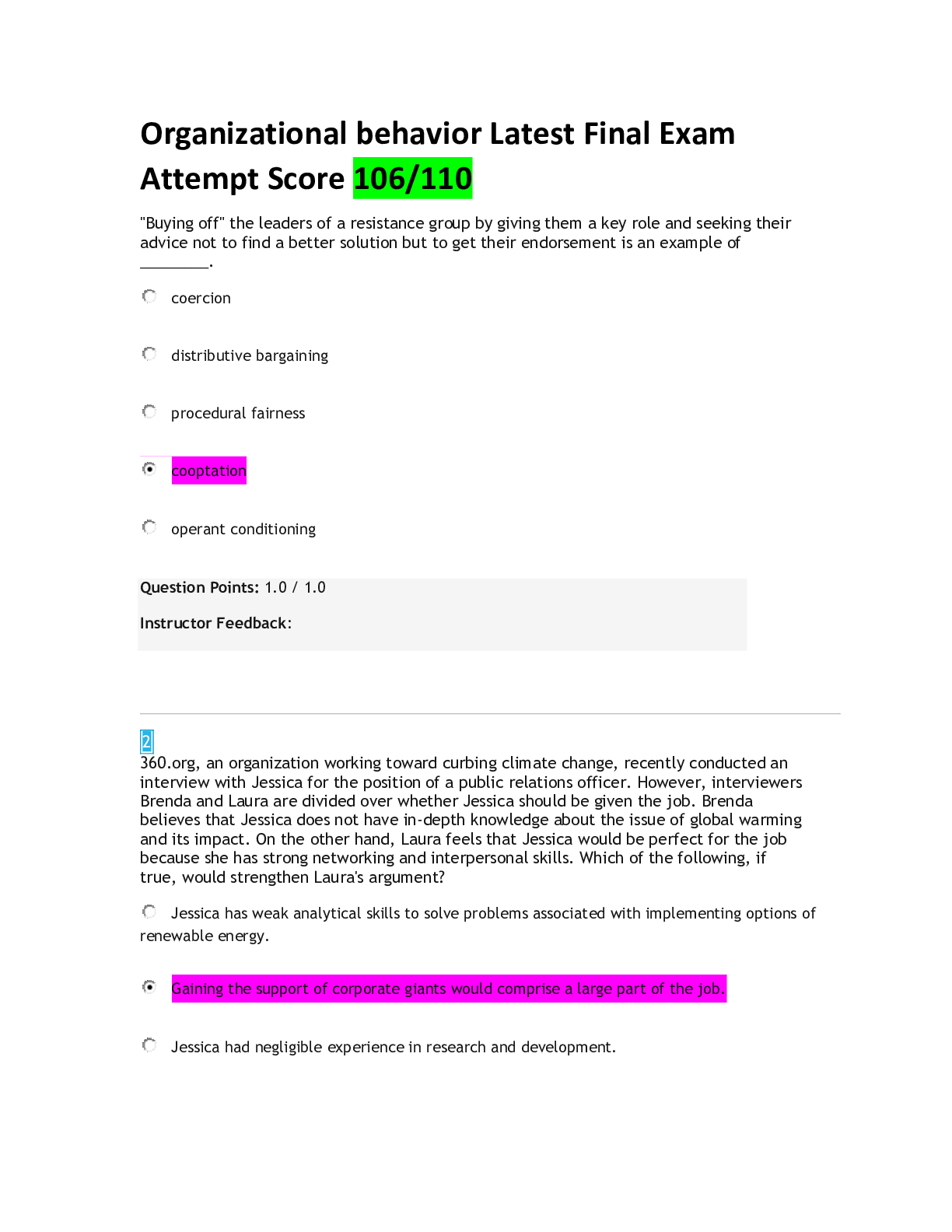Anthropology > EXAM > ANT 3520 Final Exam | Answered with complete solutions (All)
ANT 3520 Final Exam | Answered with complete solutions
Document Content and Description Below
ANT 3520 Final Exam | Answered with complete solutions The Joint POW/MIA Accounting Command Central Identification Laboratory (JPAC-CIL) is known for: Identifying missing U.S. servicemembers Which ... of the following components are assessed or determined by forensic anthropologists? a. Sex b. Ancestry c. Age d. Manner of death e. A, B, C only Which of the following is NOT one of the sub-specialties of biological anthropology? a. Primatology b. Archaeology c. Morphology d. Paleoanthropology e. Forensic Identification Which of the following statements about anthropology are FALSE: a. Anthropology is a holistic science b. Anthropologists do not believe that culture exists c. Anthropologists search for testable explanations for natural phenomena d. Anthropologists strive to understand ultimate truths about humanity e. None of the above f. B and D Which of these is NOT a primary subfield of Anthropology? a. Cultural Anthropology b. Forensic Anthropology c. Linguistic Anthropology d. Archaeology e. Biological Anthropology The Parkman murder case is important because It is one of the first cases that uses forensic anthropological techniques The facility that opened at the University of Tennessee in 1980: a. Led to the formation of the Hamann-Todd Skeletal Collection b. Was overseen by Dr. William "Bill" Bass c. Is devoted to the study of human decomposition d. All of the above e. A and B f. B and C Who was the founder of the C.A. Pound Human Identification Laboratory? William Maples In what instance would a forensic anthropologist analyze historical remains? The case has forensic merit What is the major problem with the Hamann-Todd and Terry Skeletal Collections? They are not representative of the entire historic U.S. population Lead, board-certified forensic pathologist, appointed by the state governor in Florida and other states Chief Medical Examiner Expert who assists Medical Examiner in identification based on dental records forensic odontologist Elected official responsible for death investigations of individuals not under the care of a physician at time of death who is usually charged with death investigation located in rural areas and consults with pathologist if an autopsy needs to be performed Coroner Expert who assists Medical Examiner in the use of plant material for death investigation forensic botanist Expert who assists Medical Examiner in recovery of human remains, assessing trauma in skeletonized or badly decomposed remains, and determining the biological profile forensic anthropologist Assists Medical Examiner in death investigation and in corresponding with Law Enforcement and family members; responsible for human remains and associated evidence Medicolegal death investigator Expert who assists Medical Examiner in the use of insects for death investigation Forensic Entomologist Licensed physician with training in forensic pathology who performs autopsy, determines cause and manner of death, and issues death certificate for individuals not under the care of a physician at time of death Medical Examiner Assists Medical Examiner during autopsy Autopsy Technician Assists Medical Examiner by collecting material evidence at the scene Law Enforcement Officer When remains are found, fleshed or skeletonized, the discoverer should: Call the police and leave them alone "Forensic" refers to: Scientific work related to the legal system in criminal and civil cases Which of these is NOT a main objective of the forensic anthropologist? a. Look for traumatic injury b. Determine time since death c. Determine cause of death d. Recover human remains e. Assist with positive identifications Which of the following would be LEAST likely to initiate a medicolegal investigation? a. A drowning witnessed by at least two other people b. A fatal fall off a ladder c. The death of an elderly patient in a nursing home d. The death of an otherwise healthy, young woman from a stroke The coroner system as we know it originated in: England Within the medicolegal system, the roles of a forensic anthropologist could include: a. Aiding in the recovery of human remains b. Riding along with the FBI to arrest suspects, just like on TV c. Conducting autopsies d. Analyzing traumatic injuries to bone e. None of the above f. C and D g. A and D Why would a state have a coroner system instead of the Medical Examiner system? There may not be enough violent crime to have a full-time medical pathologist Which of these is a manner of death? a. Falling from a tree b. Gunshot wound to the head c. Homicide d. Getting hit by a bus e. Stab wound to the abdomen Which of the following experts consult with medical examiners on forensic cases? a. Law Enforcement b. Anthropologists c. Odontologists d. DNA specialists e. All of the above A Medicolegal Death Investigator: Acts as a liaison between the Medical Examiner and the Family Upon arrival to the scene, the person claiming to have buried the remains is unable to recall the exact location. What is the simplest noninvasive technique you can use to try to locate the remains? line search pedestrian search pedestrian survey Since this is purportedly a burial, what can you tell your team to look for in order to potentially identify its location? I would tell my team to keep a look out for surface depression or mounds, soil color, vegetation, scavenging, and personal evidence (example: clothes/keys/wallet) Local law enforcement has contacted your laboratory because a person has come forward claiming to have buried human remains in a nearby wooded area. They ask for your assistance in the location and recovery of the purported human remains and any associated material evidence. List at least five items you should include in your field kit before leaving the lab. Journal Camera Measuring tape compass stadia rod Which of these is NOT a type of search technique? a. Line search b. Random search c. Grid search d. Circular search The recovery of human remains typically involves: a. A lot of time b. Experience in archaeological techniques c. Using heavy machinery only (no shovels/trowels) d. Setting up a datum and a baseline e. A, B, and D What is the corpus delicti? The primary evidence that a crime has been committed Which of the following is the definition of In situ? in place, as found Which of these is NOT a stage of recovery? a. Establish a datum b. Excavate the remains c. Collect the remains d. Scrape soil down beneath the remains e. Analyze the remains The next best step once locating the remains is to begin removing them from the ground and placing them into evidence bags. true/false False The relationship among items of evidence and between the greater crime scene and the world at large is referred to as: Context Locating a clandestine burial can be done using: Ground penetrating radar The observation of vegetation changes Cadaver dogs Field-searching in a line Why is a grid system often used in field recoveries? a. When site is visualized as a grid, it's easy to keep track of where evidence came from. b. Each square of the grid can be carefully excavated independently of the others. c. Grid systems tie in well with datum points. The recovery process is documented in all of the following ways EXCEPT: a. Field notes b. Sketch maps c. Processing log d. Photography A datum is a Fixed point from which all bones and evidence can be measured Why do forensic anthropologists do peer reviews? As a means of quality assurance - to double-check analyses and reports. Audits can be performed by the following individuals: a. External auditors b. Inferior auditors c. Superior auditors d. Internal auditors e. A and D In report writing, Everything that appears in the report should appear in the notes The surety portion of the SOP involves all of the following portions EXCEPT: a. Taphonomy b. Peer review c. Audits d. Training At the C.A. Pound Human Identification Laboratory, the following materials are used for maceration: Simmering water Skeletal analysis at the CAPHIL includes a. Inventory b. Photography and Radiography c. Biological Profile estimation d. Field notes A, B, and C Taphonomy and Trauma forms are examples of: Open forms because there are no specified methods on the form itself In the cleaning of remains, plastic tools are used because: They prevent damage to the remains Which of the following forms are used in forensic anthropological lab analysis? a. Skeletal inventory form, trauma form, forms for the biological profile b. SOP, audit form c. Skeletal inventory form only d. Trauma form only e. Biological profile forms only The process of maceration includes Cleaning the bone of all soft tissue Taphonomy literally means The laws of burial Which of these is NOT representative of weathering on bone? a. Delaminating b. Shrinkage c. Sun bleaching d. Root etching What is a N'ganga? Cauldron used to perform rituals in Palo Mayombe Postmortem damage can be distinguished from perimortem damage by Color of the fracture Forensic anthropologists may use taphonomy to aid in determining The time since death Locard's exchange principle states that: Every contact leaves a trace Bone can appear in different colors due to a. Sun bleaching b. Coffin staining c. Burning d. All of the above e. None of the above Changes in algor mortis and other decompositional factors are: Highly environmentally-dependent The settling of the blood in a body after death is known as Livor mortis After 24 hours after death, the Medical Examiner and her consultants may look at _____ to determine time since death? a. Entomology b. Botany c. Taphonomy d. Decomposition e. All of the above Which of these bones is NOT found in humans? a. Baculum b. Coracoid c. Tibiotarsus d. All of the above e. None of the above Maximum cranial length is measured with: Spreading calipers The fibula is ________________ to the tibia Lateral The bones of the leg include: Femur, patella, tibia Osteometry is: The measurement of bone and skeletal materials The sternum is _________ to the vertebrae: Anterior The two types of bone formation are Intramembranous and Endochondral The human vertebral column CANNOT be characterized by: a. Four curvatures b. Ribs that articulate only with the cervical vertebrae c. Vertebrae that increase in size d. Ribs that articulate only with the thoracic vertebrae The average difference in size between male and female humans is 15% The determination of sex from the skeleton is performed using what/which method? a. Visual assessment b. Metric assessment c. Aural assessment d. All of the above e. Both A and B Which of these is typical of a female pelvis: a. Wide subpubic angle b. Narrow subpubic angle c. Wide sciatic notch d. None of the above e. Both A and C The ______is the second best area to look when determining sex. Skull What is sexual dimorphism? Physical differences between males and females of the same species The pelvis is the best place to assess______________. Sex As compared to males, the pelvic outlet in females tends to be Large and unobstructed Differences in the pelvis between human males and females are primarily due to The need to accommodate for childbirth Why might a large female be at a disadvantage (as compared to a smaller female)? Gestation and lactation require a large amount of energy Which of the following traits is most commonly observed in males? a. Vertical, gracile forehead b. Large mastoid processes c. Pointed chin d. Sharp orbital margins During which life-stage is age most accurately estimated? Childhood The rule of thumb for estimating fetal development from crown-to-heel length measurements is known as what? Haase's rule Of the six major joints, the bones of the shoulder will fuse Sixth Techniques of subadult age estimation are based on multiple _________ processes. Developmental The last epiphysis to fuse is the Clavicle Fill in the blanks: You can age a(n) ________________ but you can't sex him/her; you can sex a(n) ________________ but you can't age him/her. child; adult As an adult individual approaches SENILITY (old age), what happens? The space between the intervertebral discs begins to shrink Of these joints, which fuses first? a. The ankle b. The elbow c. The wrist d. The knee e. The hip Which of the following has 6 morphological stages? a. Cranial suture closure b. Auricular surface c. Suchey-Brooks pubic symphysis method d. A and C only e. None of the above Which of the following is an age indicator for adults? [Show More]
Last updated: 8 months ago
Preview 5 out of 21 pages

Loading document previews ...
Buy this document to get the full access instantly
Instant Download Access after purchase
Buy NowInstant download
We Accept:

Reviews( 0 )
$16.00
Can't find what you want? Try our AI powered Search
Document information
Connected school, study & course
About the document
Uploaded On
Oct 13, 2024
Number of pages
21
Written in
Additional information
This document has been written for:
Uploaded
Oct 13, 2024
Downloads
0
Views
39


